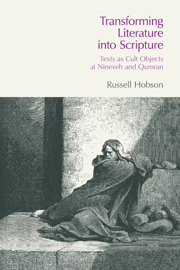Book contents
- Frontmatter
- Contents
- Acknowledgements
- Abbreviations
- 1 Authoritative Texts in the Hebrew and Cuneiform Traditions
- 2 Formulating a New Comparative Approach
- 3 Choosing the Right Texts
- 4 Study One: Enūma Anu Enlil Tablet 63
- 5 Study Two: Mul.Apin
- 6 Study Three: The Laws of Hammurabi
- 7 Study Four: Tablet XI of the Epic of Gilgamesh
- 8 Study Five: Mīs Pî
- 9 Study Six: Manuscripts of Pentateuchal Texts from Near the Dead Sea
- 10 Interpreting the Evidence
- Notes
- Bibliography
- Index of Ancient References
- Index of Authors
- Index of Subjects
1 - Authoritative Texts in the Hebrew and Cuneiform Traditions
- Frontmatter
- Contents
- Acknowledgements
- Abbreviations
- 1 Authoritative Texts in the Hebrew and Cuneiform Traditions
- 2 Formulating a New Comparative Approach
- 3 Choosing the Right Texts
- 4 Study One: Enūma Anu Enlil Tablet 63
- 5 Study Two: Mul.Apin
- 6 Study Three: The Laws of Hammurabi
- 7 Study Four: Tablet XI of the Epic of Gilgamesh
- 8 Study Five: Mīs Pî
- 9 Study Six: Manuscripts of Pentateuchal Texts from Near the Dead Sea
- 10 Interpreting the Evidence
- Notes
- Bibliography
- Index of Ancient References
- Index of Authors
- Index of Subjects
Summary
The Stabilization of Texts in Authoritative Collections
It is widely recognized that the discovery of the Dead Sea Scrolls has changed our understanding of the development of Jewish sacred literature. In particular, the vigorous study of the biblical scrolls from Qumran has brought to light a stage in the formation of the Hebrew Scriptures that was unimagined by scholars before the discovery and subsequent analysis of these texts in the second half of the twentieth century. The wealth of manuscript evidence from the caves near Qumran has revealed that our concept of a “Hebrew Bible,” with its closed list of books and fixed textual form, was entirely absent in the late Second Temple period. Rather, this period represents a stage in which the biblical texts were still in the final stages of production, and were decidedly fluid both in terms of their position in the recognized collections of authoritative scrolls, and in terms of their literary editions and precise textual forms.
Indeed, scholars of canonical criticism no longer talk of a definitive event, once thought to have occurred in the first century ce, in which the canonization of the Hebrew Bible was finally decided. Instead, they describe a centuries long “canonical process” which centred around “a collection of authoritative scriptures.” Similarly, the terminology that surrounds the textual form of individual biblical texts has undergone a transformation.
- Type
- Chapter
- Information
- Transforming Literature into ScriptureTexts as Cult Objects at Ninevah and Qumran, pp. 1 - 7Publisher: Acumen PublishingPrint publication year: 2012



